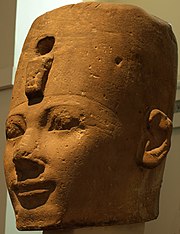Portal:Ancient Egypt/Selected biography/7

Thutmose I (sometimes read as Thothmes, Thutmosis or Tuthmosis I) was the third Pharaoh of the Eighteenth Dynasty of Egypt. He was given the throne after the death of the previous king Amenhotep I. During his reign, he campaigned deep into the Levant and Nubia, pushing the borders of Egypt further than ever before. He also built many temples in Egypt and built a tomb for himself in the Valley of the Kings; he is the first king confirmed to have done this (though Amenhotep I may have preceded him). He was succeeded by his son Thutmose II, who in turn was succeeded by Thutmose II's sister, Hatshepsut. His reign is generally dated from 1506 to 1493 BCE. Thutmose I's mummy was ultimately discovered in the Deir el-Bahari Cache above the Mortuary Temple of Hatshepsut, revealed in 1881. He had been interred along with those of other 18th and 19th dynasty leaders Ahmose I, Amenhotep I, Thutmose II, Thutmose III, Ramesses I, Seti I, Ramesses II, and Ramesses IX, as well as the 21st dynasty pharaohs Pinedjem I, Pinedjem II, and Siamun. The original coffin of Thutmose I was taken over and re-used by a later pharaoh of the 21st dynasty. The mummy of Thutmose I was thought to be lost, but Egyptologist Gaston Maspero, largely on the strength of familial resemblance to the mummies of Thutmose II and Thutmose III, believed he had found his mummy in the otherwise unlabelled mummy #5283. This identification has been supported by subsequent examinations, revealing that the embalming techniques used came from the appropriate period of time, almost certainly after that of Ahmose I and made during the course of the Eighteenth Dynasty.
